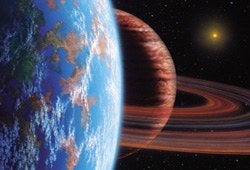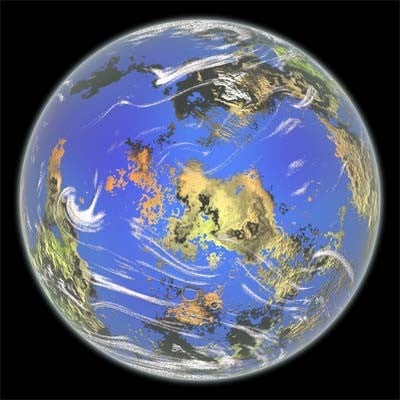Based on detailed computer simulations, British astronomers have found that half of the 130-plus stars with known planets have habitable zones in which earthlike planets could orbit long enough for life to appear. The finding should encourage observers to search for terrestrial planets even around stars circled by “hot Jupiters.”
A team led by astrophysicist Barrie Jones at Open University, near London, launched virtual Earths into a variety of orbits within nine representative exoplanetary systems out of the 134 currently known. They then watched each system evolve for up to a billion years — the longest such studies so far.
Based on these computer experiments the researchers derived a set of rules that predict how long an Earth-mass planet can stay within a star’s “Goldilocks zone” — the region in which the temperature is “just right” for water on a planet’s surface not to freeze or boil. “If liquid water can exist,” Jones says, “so could life as we know it.”
In some cases, a giant planet’s disaster zone includes its star’s entire habitable zone, ruling out a world on which life could develop. However, in many other systems the disaster zones and habitable zones overlap only partially, temporarily, or not at all.
When the team applied their survival rules to the known planetary systems, they found that close to half of them could have harbored habitable worlds for the past billion years — long enough for life to develop.
These systems should be high on the target list for exploration for terrestrial planets, the researchers say.
Even more planets might once have harbored life, the researchers suggest. As a main-sequence star ages, its habitable zone drifts outward. Some planets may have spent a billion years or more in a Goldilocks zone that has since passed them by. “Over the course of their entire stellar lifetimes, two-thirds of the systems could have habitable bodies at some time during their existence,” says David Underwood, one of the Open University researchers.
He and his colleagues are quick to point out that they did not try to determine if Earth-mass planets actually could form within these stars’ habitable zones, but only if they could survive once formed. How readily earthlike planets form, they say, is an urgent question that needs further study.
Avi Mandell, who researches planet formation at Pennsylvania State University, agrees, but still values the current findings. “If their results are robust,” he says, “it suggests that our preconceptions of the type of planetary systems that may host habitable or even inhabited planets need to be re-examined.”











